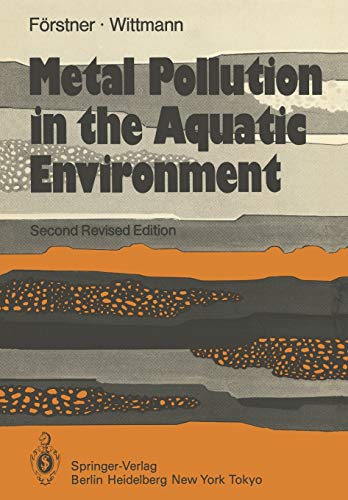Articoli correlati a Metal Pollution in the Aquatic Environment

Le informazioni nella sezione "Riassunto" possono far riferimento a edizioni diverse di questo titolo.
Le informazioni nella sezione "Su questo libro" possono far riferimento a edizioni diverse di questo titolo.
- EditoreSpringer Verlag
- Data di pubblicazione1983
- ISBN 10 3540128565
- ISBN 13 9783540128564
- RilegaturaCopertina flessibile
- Numero edizione2
- Numero di pagine512
Compra nuovo
Scopri di più su questo articolo
Spese di spedizione:
GRATIS
In U.S.A.
I migliori risultati di ricerca su AbeBooks
Metal Pollution in the Aquatic Environment (Springer Study Edition) by Förstner, U., Wittmann, G. T. W. [Paperback ]
Descrizione libro Soft Cover. Condizione: new. Codice articolo 9783540128564
Metal Pollution in the Aquatic Environment (Springer Study Edition)
Descrizione libro Condizione: New. Codice articolo ABLIING23Mar3113020159975
Metal Pollution in the Aquatic Environment
Print on DemandDescrizione libro Condizione: New. PRINT ON DEMAND Book; New; Fast Shipping from the UK. No. book. Codice articolo ria9783540128564_lsuk
Metal Pollution in the Aquatic Environment
Descrizione libro Taschenbuch. Condizione: Neu. This item is printed on demand - it takes 3-4 days longer - Neuware -Aquatic chemistry is becoming both a rewarding and substantial area of inquiry and is drawing many prominent scientists to its fold. Its literature has changed from a compilation of compositional tables to studies of the chemical reactions occurring within the aquatic environments. But more than this is the recognition that human society in part is determining the nature of aquatic systems. Since rivers deliver to the world ocean most of its dissolved and particulate components, the interactions of these two sets of waters determine the vitality of our coastal waters. This significant vol ume provides not only an introduction to the dynamics of aquatic chem istries but also identifies those materials that jeopardize the resources of both the marine and fluvial domains. Its very title provides its emphasis but clearly not its breadth in considering natural processes. The book will be of great value to those environmental scientists who are dedicated to keeping the resources of the hydrosphere renewable. As the size of the world population becomes larger in the near future and as the uses of materials and energy show parallel increases, the rivers and oceans must be considered as a resource to accept some of the wastes of society. The ability of these waters and the sediments below them to accommodate wastes must be assessed continually. The key questions relate to the capacities of aqueous systems to carry one or more pollutants. 512 pp. Englisch. Codice articolo 9783540128564
Metal Pollution in the Aquatic Environment
Descrizione libro Condizione: New. Dieser Artikel ist ein Print on Demand Artikel und wird nach Ihrer Bestellung fuer Sie gedruckt. Aquatic chemistry is becoming both a rewarding and substantial area of inquiry and is drawing many prominent scientists to its fold. Its literature has changed from a compilation of compositional tables to studies of the chemical reactions occurring within . Codice articolo 4881967
Metal Pollution in the Aquatic Environment
Descrizione libro Taschenbuch. Condizione: Neu. Druck auf Anfrage Neuware - Printed after ordering - Aquatic chemistry is becoming both a rewarding and substantial area of inquiry and is drawing many prominent scientists to its fold. Its literature has changed from a compilation of compositional tables to studies of the chemical reactions occurring within the aquatic environments. But more than this is the recognition that human society in part is determining the nature of aquatic systems. Since rivers deliver to the world ocean most of its dissolved and particulate components, the interactions of these two sets of waters determine the vitality of our coastal waters. This significant vol ume provides not only an introduction to the dynamics of aquatic chem istries but also identifies those materials that jeopardize the resources of both the marine and fluvial domains. Its very title provides its emphasis but clearly not its breadth in considering natural processes. The book will be of great value to those environmental scientists who are dedicated to keeping the resources of the hydrosphere renewable. As the size of the world population becomes larger in the near future and as the uses of materials and energy show parallel increases, the rivers and oceans must be considered as a resource to accept some of the wastes of society. The ability of these waters and the sediments below them to accommodate wastes must be assessed continually. The key questions relate to the capacities of aqueous systems to carry one or more pollutants. Codice articolo 9783540128564
Metal Pollution in the Aquatic Environment (Springer Study Edition)
Descrizione libro Paperback. Condizione: Brand New. softcover reprint of the original 2nd ed. 1981 edition. 512 pages. 9.61x6.69x1.16 inches. In Stock. Codice articolo x-3540128565

